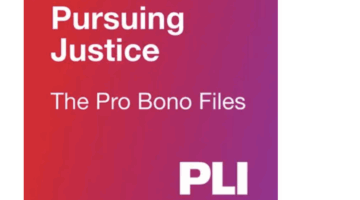“Incredibly weird.” This was, in fairness to Judge Richard Posner, what he thought of homosexuality as a 13-year-old boy, back in 1952. His Honor has come a long way since then.
Recall how Judge Posner benchslapped lawyers arguing against gay marriage at oral argument; wrote what Mark Joseph Stern of Slate called a “witty, deeply moral masterpiece” of an opinion striking down same-sex marriage bans; and chastised Chief Justice John Roberts for what Judge Posner called a “heartless” dissent in Obergefell v. Hodges, the Supreme Court’s ruling in favor of nationwide marriage equality in June of this year.
Judge Posner wasn’t always a proponent of marriage equality. Observers have pointed out past writings of his in which he argued that same-sex marriage was not a “feasible proposal” because “public hostility to homosexuals” was “too widespread,” for example.

The Trump Gold Card: A New $1 Million Pathway To A U.S. Green Card
A new proposal would let wealthy foreign nationals secure an opportunity for a U.S. green card with a $1 million 'gift' to the government, sparking legal and ethical debate.
But like certain other public figures — e.g., Hillary Clinton — Judge Posner has, with the passage of time, come around on gay marriage. He explains his change of heart in a fascinating Yale Law Journal piece, a “re-review” of Yale law professor William N. Eskridge’s 1996 book, The Case for Same-Sex Marriage: From Sexual Liberty to Civilized Commitment (affiliate link), which Posner reviewed for the Michigan Law Review some 18 years ago. From his re-review (emphases added and footnotes omitted in all block quotations here; it’s a law review article, so there are a lot of footnotes):
I am going to trace the evolution of my thinking about homosexuality back to 1952, when I was thirteen years old. It was about then that I first heard about homosexuality, though I don’t remember how I heard about it; I’m sure it was never mentioned by my parents. I considered it incredibly weird. In part for that reason I didn’t think I’d ever actually meet a homosexual. Not that I felt hostility toward them, any more than I did toward Eskimos; they seemed alien, but not threatening….
In our defense, we have much better fashion sense than Eskimos.
My 1992 book Sex and Reason [affiliate link], my first academic foray into sex, originated in a case my court had heard en banc that involved nude dancing in a strip joint—the Kitty Kat Lounge—in South Bend, Indiana. The State wanted to forbid such dancing, primarily on the ground that it was likely to promote illegal activity, mainly prostitution. My court held that the dancing was protected by the First Amendment’s Free Speech Clause, but the Supreme Court reversed. I was struck by the ignorance of the lawyers and judges (myself included) about erotic dancing….

Pursuing The Pro Bono Story: A Conversation With Alicia Aiken
This Pro Bono Week, get inspired to give back with PLI’s Pursuing Justice: The Pro Bono Files, a one-of-a-kind podcast hosted by Alicia Aiken.
Speak for yourself, Judge Posner. Former federal judges Jack Camp (N.D. Ga.) and Edward Nottingham (D. Colo.) have extensive firsthand knowledge about erotic dancing. So does this Biglaw partner and these summer associates.
Judge Posner defends his prior writings about homosexuality (and I think he’s quite right to do so; there’s no animus in them, just the operation of Posner’s detached, formidable intellect):
My book was “pro-homosexual” by the standards of the time. I rejected the notion still current then (but no longer) that heterosexuals could be “recruited” to be homosexual rather than that homosexual preference is an innate characteristic. I argued in like vein that homosexuals could not be converted to heterosexuality. I argued that they should be allowed to serve in the armed forces (they weren’t then, at least officially; oddly there had been no bar to their serving in the armed forces before World War II).
I was agnostic about whether homosexual marriage should be permitted. I listed some objections (of which one, now obsolete and probably silly even when I made it, was: “Should we worry that a homosexual might marry a succession of dying AIDS patients in order to entitle them to spouse’s medical benefits?”).
This objection does seem far-fetched. Perhaps Judge Posner was, like me, watching too much Melrose Place back then.
(Professor Eskridge dismissed Judge Posner’s scenario as a “lavender herring.” Judge Posner’s response, in footnote 18 of his YLJ piece: “I don’t know what a ‘lavender herring’ is, but it doesn’t sound good.”)
Back to Posner’s re-review:
I concluded that “[n]one of these points is decisive against permitting homosexual marriage. All together may not be. The benefits of such marriage may outweigh the costs.” But since, at the time I was writing, authorizing homosexual marriage was simply out of the question, I added that “maybe the focus should be shifted to an intermediate solution that would give homosexuals most of what they want”—and I pointed to Denmark’s “registered partnership” and Sweden’s “homosexual cohabitation” as examples of such a solution.
That was, by the standards of its time, a rather progressive position from Judge Posner. But it didn’t go far enough for Professor Eskridge, who dismissed registered partnership as a “halfway house to marriage,” before going on to make what Posner describes as “almost all the arguments that have been advanced in the recent wave of litigation culminating in the Supreme Court’s decision in Obergefell v. Hodges.”
The bottom line: back in the 1990s, Judge Posner was somewhat open to same-sex marriage as a policy matter (to be decided by a legislature), but not as a matter of constitutional law (to be decided by a court). What led him to decide, in the 2014 case of Baskin v. Bogan, that the Constitution requires marriage equality?
By the summer of 2014, the tide was running strongly in favor of invalidating such prohibitions, although it was not certain that the Supreme Court would go with the tide. I do think the change in public opinion was decisive for all the courts that ruled in favor of creating a constitutional right to same-sex marriage. Law is not a science, and judges are not calculating machines. Federal constitutional law is the most amorphous body of American law because most of the Constitution is very old, cryptic, or vague. The notion that the twenty-first century can be ruled by documents authored in the eighteenth and mid-nineteenth centuries is nonsense.
The arguments against same-sex marriage were never strong. They didn’t need to be when there was overwhelming passionate objection to such marriage. When the objection faded (not completely, but to a great extent, and with remarkable speed), the absence of strong arguments against same-sex marriage, and the presence of strong arguments in favor of it, became the decisive factors guiding judicial action.
And what led to this crucial shift in public opinion? This argument from Judge Posner might be analytically correct, but not politically correct:
I want to say a little more about the change in public opinion that set the stage for Obergefell, and this will allow me to return to where I started in this Review, with my youthful discovery that there was this strange phenomenon called homosexuality. In those days a great many homosexuals concealed their homosexuality from heterosexuals in order to avoid the discrimination against homosexuals that was then rampant. The result was that those who flaunted their homosexuality—whose mannerisms or dress or occupations signaled homosexuality—were taken by heterosexuals to be typical of homosexuals, and were derided, especially since, in a prissier era than today, homosexual sex was criminalized by many states. (I am speaking primarily of male homosexuals, who have always received more critical attention than lesbians.)
But beginning in the 1960s with the Alfred Kinsey reports revealing a greater amount of promiscuity than conventional people realized existed, there was a loosening of sexual mores in general and among its effects was an increasing tolerance of homosexuals. Gradually, as that tolerance grew, fewer homosexuals bothered concealing the fact of their being homosexual. As homosexuals not readily recognizable as such by reason of mannerism, dress, or occupation began to acknowledge, or at least cease denying or trying to conceal, their homosexuality, heterosexuals discovered that most homosexuals are indistinguishable in any respect except sexual preference from heterosexuals; and so it became difficult to understand why they should be discriminated against.
Translation: do we owe marriage equality to “butch” as opposed to “queeny” gay men? The ruggedly handsome cowboys of Brokeback Mountain, not the contestants on RuPaul’s Drag Race? The masculine Will Truman of Will & Grace, not the flamboyant Jack McFarland? Like pretty much everything emanating from Posner’s pen (or keyboard), it’s an interesting and thought-provoking theory, even if it might make some members of the LGBT community uncomfortable.
Judge Posner closes his re-review by acknowledging one person who definitely deserves credit for making marriage equality a reality:
[Professor Bill] Eskridge’s position has triumphed. It’s a shame that Justice Kennedy’s opinion did not cite his book. Nor did any of the four dissents cite his book; nor for that matter had I cited it in my opinion in Baskin. I had forgotten his book, forgotten my review of it, and forgotten what I had said about same-sex marriage in Sex and Reason and the subsequent book reviews that I mentioned here. A prophet before his time, William Eskridge has the satisfaction of having finally been vindicated.
And that is a position that we can all agree upon. Thinkers like Bill Eskridge, Evan Wolfson, and Andrew Sullivan — and so many other writers, scholars, lawyers, and activists, too many to mention here — played a critical role in turning gay marriage from something “incredibly weird” into the law of the land.
P.S. I can relate to “evolving” on gays and gay marriage: I went from snarking on National Coming Out Day as a conservative columnist for the Harvard Crimson to coming out (and eventually getting gay-married) myself. To hear my apology and explanation, listen to my interview with Marty Moss-Coane of WHYY Radio Times.
UPDATE (12/1/2015, 8:00 a.m.): For comments critical of Judge Posner’s approach to judging as outlined in his Yale Law Journal essay, see, e.g., Josh Blackman and Ilya Somin.
Eighteen Years On: A Re-Review [Yale Law Journal via How Appealing]
Earlier: Judge Posner’s Blistering Benchslaps At The Same-Sex Marriage Arguments
Reverse Benchslap Of The Day: Judge Posner Smacks Chief Justice Roberts
Judge Posner Drops Truth Bombs Like It Ain’t No Thang